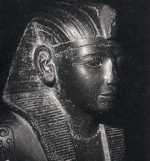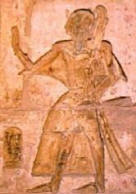|
How the XXth
Dynasty gained power remains unclear. The only
indications of the political events at this date derive
from a stele erected on the island of Elephantine by its first ruler,
Setkhnakht, and an account written down in the Great Harris Papyrus from the
biggining of the reign of Ramesses IV. On the stele, Sethnakht relates how he
expelled rebels who on their flight left behind the gold, silver, and copper
they had stolen from Egypt and with which day had wanted to hire reinforcements
among the Asiatics. The papyrus describes how a state of lawlessness and chaos
had broken out in Egypt because of forces from 'outside'; after several years in
which there was no one who ruled, a Syrian called Iarsu (a made-up name meaning
'one who made himself' ) seized power, and his confederates plundered the
country; they treated the gods like ordinary human beings and no longer
sacrificed in the temples. From these texts we may perhaps conclude that,
after the death of Taweseret, Bay had tried to seize power and may even have
succeeded for a brief time until he was expelled by
Sethnakht. |
||

 O
O
 S
S S
S T
T D
D